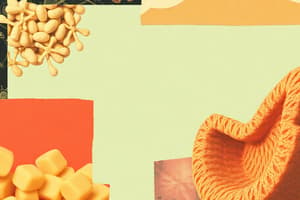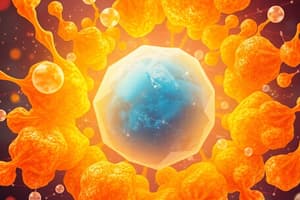Podcast
Questions and Answers
Glycogen serves as a storage form of sugar in plants.
Glycogen serves as a storage form of sugar in plants.
False (B)
Lactose, commonly found in milk, is classified as a disaccharide.
Lactose, commonly found in milk, is classified as a disaccharide.
True (A)
Fructose, also recognized as fruit sugar, falls under the category of polysaccharides.
Fructose, also recognized as fruit sugar, falls under the category of polysaccharides.
False (B)
Sucrose, frequently utilized as table sugar, is categorized as a monosaccharide.
Sucrose, frequently utilized as table sugar, is categorized as a monosaccharide.
Maltose is a disaccharide. When broken down, maltose yields two fructose molecules.
Maltose is a disaccharide. When broken down, maltose yields two fructose molecules.
Flashcards
Monosaccharides
Monosaccharides
Simple sugars that are the basic building blocks of carbohydrates, like glucose, fructose, and galactose.
Disaccharides
Disaccharides
Sugars composed of two monosaccharides linked together, such as sucrose, maltose, and lactose.
Sucrose
Sucrose
Table sugar; composed of glucose and fructose.
Lactose
Lactose
Signup and view all the flashcards
Polysaccharides
Polysaccharides
Signup and view all the flashcards
Study Notes
- Monosaccharides include glucose, fructose (fruit sugar), and galactose.
- Disaccharides include sucrose (table sugar, sweeteners), maltose, and lactose (milk sugar).
- Polysaccharides include glycogen (the storage form of sugar in animals) and starch (the storage form of sugar in plants).
Studying That Suits You
Use AI to generate personalized quizzes and flashcards to suit your learning preferences.




